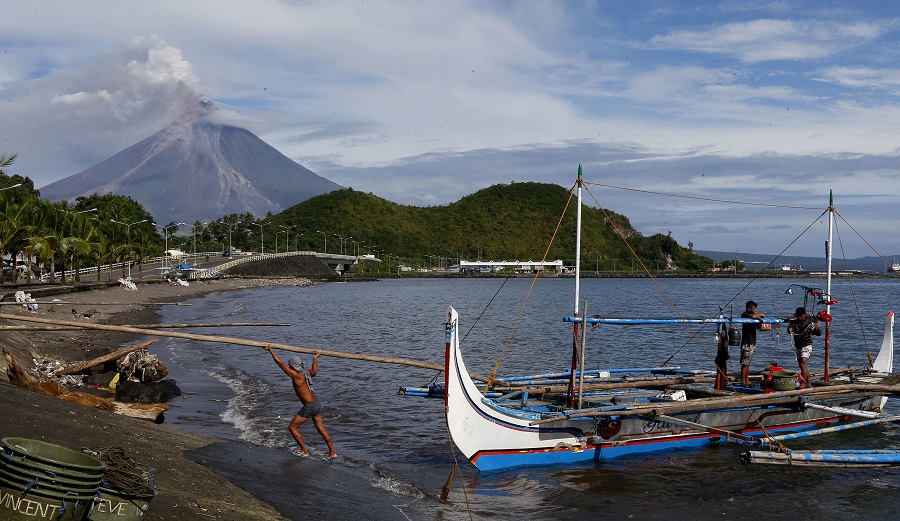Philippines volcano Mount Mayon erupts, forcing 74,000 people to evacuate nearby villages

For nearly two weeks, intense activity from Mount Mayon in the Philippines has disrupted life for thousands in the region.
The Philippine Institute of Volcanology and Seismology (PHIVOLCS-DOST) describes the several bouts of activity as “episodes of intense but sporadic lava fountaining from the summit crater,” along with multiple “tremor events” and “numerous rockfall events.”
Originally 56,217 people were forced out of the Legazpi region to seek shelter in evacuation camps scattered across nine nearby cities, however, in the span of one evening this number increased to 74,000 evacuees in 66 emergency shelters. Parents fear their children will fall behind in their education. To secure an uninterrupted schedule, temporary learning centers will become available within evacuation camps.
Another concern for locals is for the safety of their farms and livestock. Because the demographic of Legazpi consists largely of farmers who sustain their livelihood from cultivating their livestock, one hectare of land near the evacuation centers will serve as an evacuation farm for animals.
“Seventy-five farming families near the danger zone had suffered almost PHP 1-million losses in production cost due to the ongoing restiveness of Mayon,” the City Agriculture Office announced.
Eager to return home, local officials warned residents to remain in evacuation sites due to the threat of pyroclastic flows — dangerously fast moving volcanic matter and super heated gas — that continue to spew out, reaching three miles from the crater, according to PHIVOLCS-DOST. To further prevent locals from returning home, Claudio Yucot, regional director of Office of Civil Defense, recommended shutting off electricity and water flow to homes within the 8 kilometer danger zone distance from the base of the volcano. Providing reassurance, emergency shelters will remain well-stocked with relief goods at least until mid-February to ensure the safety of residents. The Australian government announced they will donate $775,000 to the Philippines Red Cross for the purchase of tarpaulins, sleeping mats, blankets, mosquito nets, jerry cans and hygiene supplies.
https://www.facebook.com/PHIVOLCS/posts/1431973000244927
“The public is strongly advised to be vigilant and desist from entering the eight (8) kilometer-radius danger zone, and to be additionally vigilant against pyroclastic density currents, lahars and sediment-laden streamflows along channels draining the edifice,” PHIVOLCS-DOST wrote in a bulletin issued on Wednesday. “Civil aviation authorities must also advise pilots to avoid flying close to the volcano’s summit as ash from any sudden eruption can be hazardous to aircraft.”
Mount Mayon is just one of 22 active volcanoes scattered among the Philippine islands. Surrounded by a number of trenches and seismic faults, The Philippines is situated along the “Ring of Fire,” a rim of seismic faults that lays beneath the surface of all Pacific ocean coastal communities. The “Ring of Fire” includes countries located within the Andes region, the Central American West Coast, the US and Canadian West Coast, Russia, Japan, Philippines, Indonesia, and New Zealand. In less than one week, a 7.9 magnitude earthquake shook the Gulf of Alaska, Mount Kusatsu-Shirane volcano erupted in Japan, a 6.0 magnitude earthquake ruptured in Indonesia, and Mount Mayon erupted in the Philippines. Mount Mayon’s most dangerous eruption took place in 1814, which buried an entire town in volcanic matter and killed more than 1,200 people.
Suggested reading
Humanitarian assistance to the Philippines (24 January 2018) – Reliefweb
Philippine Volcano Erupts, Causing 56,000 To Flee – NPR
Philippines braces for long emergency as volcano erupts – ABC News
Legazpi puts up animal evacuation center – Philippine News Agency
Fiery Philippine Volcano Mount Mayon Forces 56,000 People to Evacuate – Wall Street Journal
UN warns Pacific Ring of Fire is ‘active’ as volcanoes erupt across Asia – Channel News Asia
